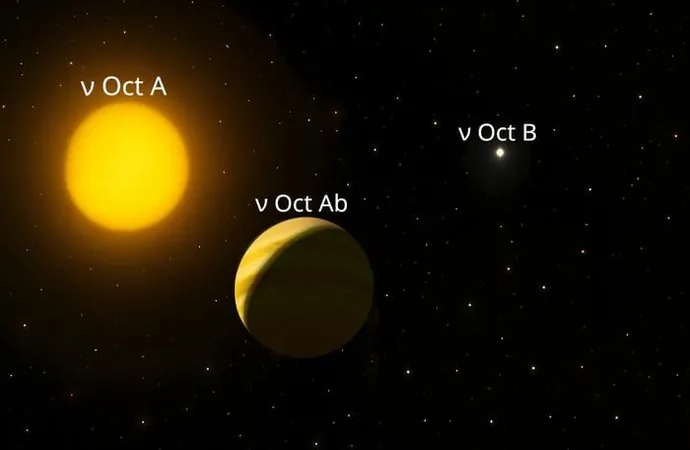
Revolutionizing Mineral Analysis: Meet MIST, the Game-Changing Algorithm!
2025-08-28
Author: Wei Ling
A Breakthrough in Mineral Identification
Scientists have unveiled MIST, an innovative algorithm that promises to transform mineral analysis by swiftly identifying minerals from chemical data. Gone are the days of tedious, expert-dependent methods—MIST automates a traditionally slow process, radically enhancing the efficiency of exploration and mining.
Say Goodbye to Slow Methods
Published in the latest issue of Computers & Geosciences, MIST stands for Mineral Identification by Stoichiometry. This cutting-edge computational tool classifies minerals based on oxide compositional data, replacing the need for slow manual petrography and spectroscopy. It offers a faster, standardized approach to process the enormous datasets generated during mineral exploration.
Developed by Leading Scientists
A talented team from Rice University's Department of Earth, Environmental and Planetary Sciences spearheaded this groundbreaking research. Their work not only marks a significant leap in geoscience data science but also aligns with the growing reliance on machine learning technologies.
Exciting Applications in Planetary Science
MIST is already making waves beyond Earth; it's being used in planetary science to analyze chemical data from NASA's Mars rovers! Initially engineered to identify minerals on Mars, this remarkable tool is proving equally valuable for mineral studies here on Earth.
Fast, Efficient, and Accessible
Kirsten Siebach, the lead author of the study and an assistant professor at Rice University, emphasized that MIST greatly simplifies a historically expertise-heavy task. "MIST takes a tedious process and makes it accessible in seconds. You don’t need to know what mineral you’re looking at—MIST can uncover it from the chemistry alone!"
Why Traditional Methods Fall Short
Identifying minerals is crucial for mining operations, significantly influencing how resources are quantified and extracted. Traditional methods rely on textures and optical properties, which are accurate but far too slow for large deposits or early-stage exploration. The complexity of mineral variability and elemental substitutions further complicates the conversion of large analytical datasets into precise mineral identifications.
The MIST Advantage
MIST tackles these challenges head-on by applying stoichiometric rules derived from well-established mineral formulas. It retrieves mineral identifications by analyzing oxide percentages, normalizing data, and cross-referencing against stoichiometric boundaries. This reliable framework can effectively handle natural substitutions like Fe, Mg, or Ca according to International Mineralogical Association standards.
A Proven Capability
When applied to vast repositories such as GEOROC, MIST successfully identified over 200 mineral species among more than 875,000 analyses. It generates standardized formulas, flags anomalies, and includes quality checks to compare actual stoichiometry with ideal values. Notable case studies have showcased MIST's prowess in identifying minerals like clinopyroxenes, feldspars, and sulfates, all while addressing elemental substitutions critical for mineral processing.
Enhancing Data Reliability
The tool not only improves the reliability of mineral databases but also enhances resource estimates and creates cleaner datasets for machine learning models. Despite some limitations, such as narrow criteria for certain minerals, MIST is a major leap forward in large-scale mineral identification.
Broadening Future Possibilities
One of MIST’s most remarkable impacts is its ability to refine large mineral databases for machine learning applications. By filtering over a million analyses from the GEOROC geochemical database, it converted 875,000 mineral records into a standardized format optimized for AI training and expansive geological research.
Quick Decisions in Exploration
MIST enables geologists to interpret geochemical data faster—an essential requirement for prompt decisions during the critical early stages of exploration. Its quality control features help detect anomalies indicative of contamination in ore samples, further fine-tuning resource estimates and improving processing strategies.
Complementing Traditional Techniques
The authors emphasize that MIST doesn’t replace traditional texture-based identification methods; rather, it acts as a rapid first-pass classification tool that directs more detailed analysis. This flexible framework can evolve to incorporate new mineral species and refine stoichiometric rules, ensuring its relevance in an ever-advancing industry.
A Future of Sustainable Resource Development
With its ability to deliver faster, scalable, and more consistent mineral identification, MIST aligns perfectly with the shift towards data-driven mining practices. This revolutionary tool not only promises greater efficiency but also paves the way for sustainable resource development.

 Brasil (PT)
Brasil (PT)
 Canada (EN)
Canada (EN)
 Chile (ES)
Chile (ES)
 Česko (CS)
Česko (CS)
 대한민국 (KO)
대한민국 (KO)
 España (ES)
España (ES)
 France (FR)
France (FR)
 Hong Kong (EN)
Hong Kong (EN)
 Italia (IT)
Italia (IT)
 日本 (JA)
日本 (JA)
 Magyarország (HU)
Magyarország (HU)
 Norge (NO)
Norge (NO)
 Polska (PL)
Polska (PL)
 Schweiz (DE)
Schweiz (DE)
 Singapore (EN)
Singapore (EN)
 Sverige (SV)
Sverige (SV)
 Suomi (FI)
Suomi (FI)
 Türkiye (TR)
Türkiye (TR)
 الإمارات العربية المتحدة (AR)
الإمارات العربية المتحدة (AR)